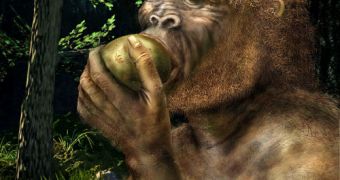Scientists say that an ancient hominid might need to be renamed, after investigations demonstrated that it may not have consumed the diet experts thought it did. The primate, called Paranthropus boisei, is oftentimes referred to as Nutcracker Man, but it apparently consumed little to no nuts at all.
This ancient, bipedal ancestor lived between 2.3 and 1.2 million years ago, and investigators consider it to be one of the distant cousins of our species. When the animal was first discovered, experts proposed that its features proposed it as a creature that consumed nuts.
However, the details of a new scientific study indicate that the classification may be wrong. For the most part, the hominid ate grass and possibly sedges, experts say, and most definitely could not crack nuts between its jaws.
The study that came to this conclusion was authored by University of Utah professor of geophysics and geology Thure Cerling, who is also a geochemist. Details of the investigation appear in the May 2 online issue of the esteemed journal Proceedings of the National Academy of Sciences (PNAS).
For the research, the expert and his team collected 24 teeth from 22 P. boisei specimens, and then conducted an analysis of the carbon isotope ratios in the enamel covering these teeth. This type of work can usually provide more insight into an animal's diet.
At first, the international scientific community classified this primate as a nutcracker because they discovered it had powerful jaws and huge molars. These signs are usually indicative of a species consuming tough foods, such as nuts, roots and seeds.
Over the past few years however, that view has come under siege, with new data showing that the scratches and wear marks on the teeth of this hominid were inconsistent with such a harsh diet.
With his new study, Cerling confirmed findings made a few years back by anthropology experts at the University of Arkansas in Fayetteville, with funding from the US National Science Foundation (NSF).
“Wherever we find this creature, it is predominantly eating tropical grasses or perhaps sedges,” the team leader explains. This is the same diet that the ancestors of zebras, pigs, warthogs and hippos consumed at the time.
“They were competing with them. They were eating at the same table,” Cerling explains.
“Frankly, we didn't expect to find the primate equivalent of a cow dangling from a remote twig of our family tree,” explains University of Colorado in Boulder (UCB) anthropology professor and study coauthor Matt Sponheimer.
“Fortunately for us, the work of several research groups over the last several years has begun to soften prevailing notions of early hominid diets. If we had presented our new results at a scientific meeting 20 years ago, we would have been laughed out of the room,” he concludes.

 14 DAY TRIAL //
14 DAY TRIAL //